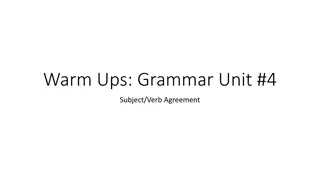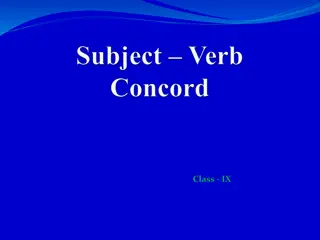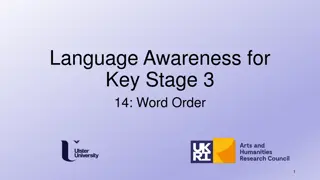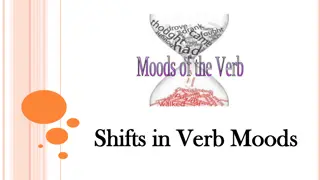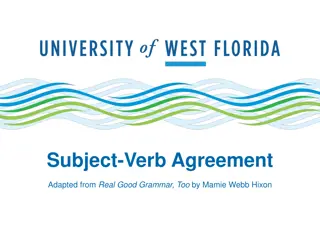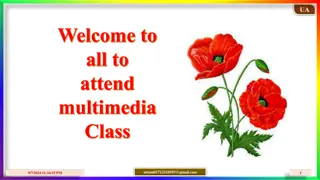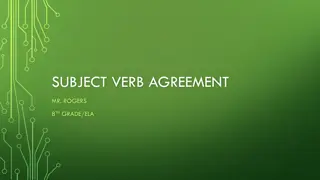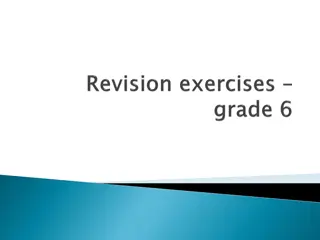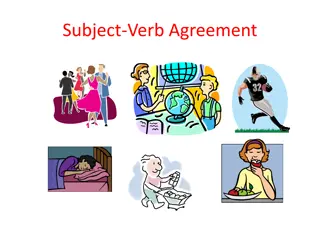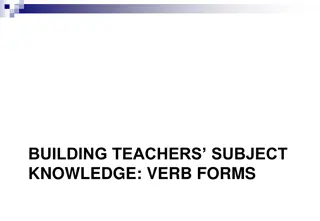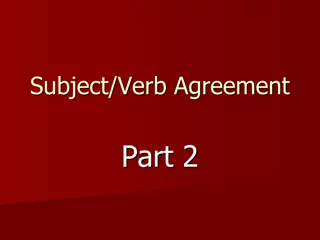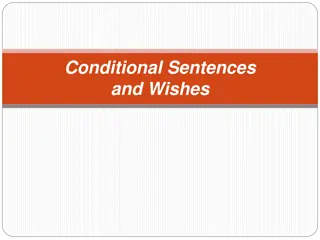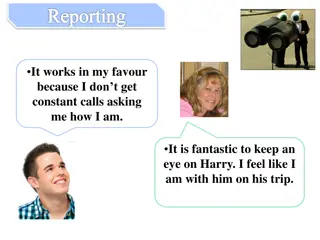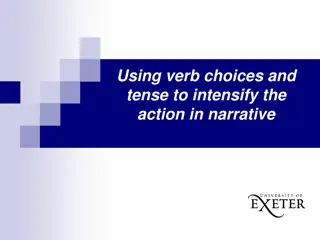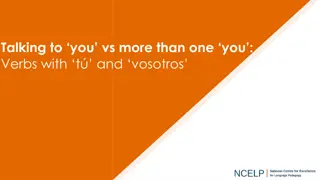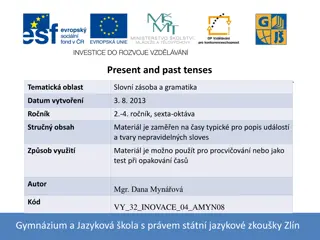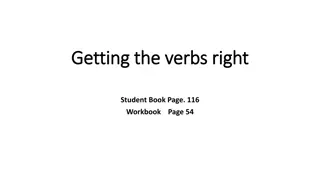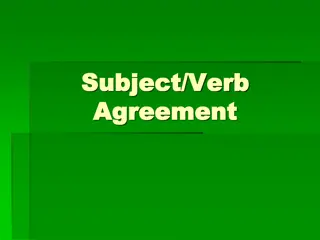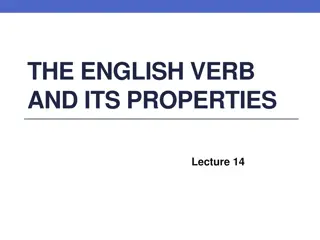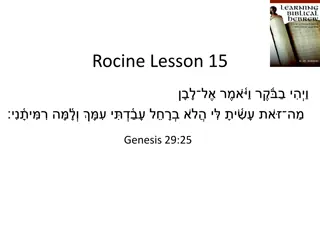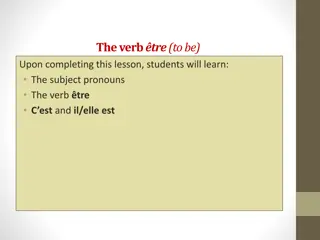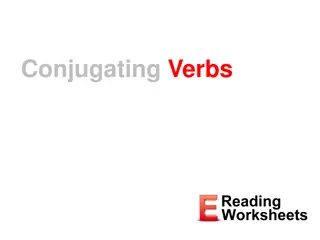Passive verb forms
Passive verb forms involve using "be" in a specific tense along with the past participle of a main verb to change the object of an active sentence into the subject of a passive sentence. The passive voice is commonly used in formal writing when the doer of the action is unknown, obvious, or purposel
2 views • 13 slides
Understanding Verb Forms and Tenses in English
Explore the different verb forms and tenses in English, including past, present, and future, as well as simple, continuous, perfect, and perfect continuous aspects. Learn how to use verb forms to create various tenses and understand when to use present, past, or future tense in different contexts.
4 views • 21 slides
Subject/Verb Agreement Practice Exercises
Practice identifying subjects and verbs, and correcting verb agreement errors in sentences. Examples include singular/plural subjects with corresponding verbs and compound subjects. Improve your understanding of subject-verb agreement through interactive exercises.
0 views • 5 slides
Understanding Subject-Verb Agreement in English Sentences
Learn about subject-verb agreement in English sentences with singular and plural nouns, first, second, and third person examples, uncountable nouns, and exceptions where plural nouns take singular verbs. Discover how to match the verb form to the subject noun in different scenarios to ensure grammat
2 views • 17 slides
Understanding Word Order in Different Languages
Explore the fascinating world of word order in languages. Discover how different languages arrange words in various ways, such as Subject-Verb-Object (SVO), Subject-Object-Verb (SOV), and more. Delve into the diversity of word orders for subjects, objects, and verbs, and uncover how language structu
2 views • 31 slides
Understanding Predicators and Predicates in Sentence Semantics
Exploring the semantics of sentences, this content delves into the structure of declarative sentences in terms of predicators and arguments. It discusses various classes of items that can function as the predicator of a sentence, such as lexical verbs, the copulative verb "be" in equative sentences,
1 views • 39 slides
Correcting Inappropriate Shifts in Verb Moods
Inappropriate shifts in verb moods can confuse readers and obscure the meaning of sentences. This article provides examples of incorrect shifts and their corrections, emphasizing the importance of maintaining consistency in verb moods within a sentence.
0 views • 13 slides
Understanding Passive Voice and Verb Forms in English
Explore the concept of passive voice in English grammar through examples and explanations of modal verbs, infinitives, gerunds, and verb forms. Learn how to form passive sentences and identify different verb structures. Practice converting active voice sentences to passive voice for a deeper underst
1 views • 9 slides
Understanding Subject-Verb Agreement in English Sentences
Subject-verb agreement is crucial in English grammar to ensure sentences are grammatically correct. The subject of a sentence must agree with the verb in terms of gender, number, person, and case. Incorrect use of verb can lead to ungrammatical sentences. Learn how the subject and verb should match
0 views • 28 slides
Language Learning Activities for Verb Conjugation
Engage in interactive language learning activities to practice verb conjugation in the first, second, and third person singular forms. From grammar face-offs to filling in missing words, these exercises will enhance your proficiency in verb conjugation skills.
0 views • 7 slides
Understanding Verb Forms and Tenses in English Grammar
Learn about verb forms and tenses in English grammar, including the five forms of every English verb, the differences between regular and irregular verbs, and how to use verb tenses such as present, present perfect, and present participle. Discover how to apply present tense in various contexts and
1 views • 15 slides
Mastering Subject-Verb Agreement for Clear Communication
Understanding subject-verb agreement is essential for clear and effective communication. Ensure that your subjects and verbs align in number, even when interrupted by phrases. Learn to identify and handle disruptive word groups, and grasp the rules for using "and" and "or" correctly. This guide help
0 views • 20 slides
Correcting Verb Tense Errors in Sentences
Correct the verb tense errors in sentences by matching verbs to their appropriate tense. Practice identifying and fixing inconsistencies in verb tenses for improved grammar accuracy.
0 views • 33 slides
Understanding Verb Forms: Lie/Lay, Sit/Set, Rise/Raise
Learn about the correct usage of transitive and intransitive verbs with examples of common verb pairs like lie/lay, sit/set, and rise/raise. Understand the distinctions between these verb forms to improve your grammar skills and communication accuracy. Enhance your knowledge through this detailed le
0 views • 4 slides
English Verb Structure Practice
Practice identifying subjects and verbs in sentences featuring the structure of "to be," "to have," and "to do." Learn about verb tenses, including present continuous, past continuous, present perfect, and past perfect. Explore the correct usage of "have," "has," and "had" as both full verbs and aux
0 views • 12 slides
Understanding Subject-Verb Agreement in English Grammar
In this multimedia class session, Assistant Head-teacher Uttam Adhikary introduces the concept of subject-verb agreement, emphasizing the importance of matching singular subjects with singular verbs and plural subjects with plural verbs. Through engaging examples and presentations, students will lea
0 views • 41 slides
Understanding Subject-Verb Agreement in English Sentences
Explore the concept of subject-verb agreement through examples about the human body. Learn about singular and plural nouns affecting verb usage, common patterns in verb endings, and exceptions to verb conjugation rules in English sentences.
0 views • 15 slides
A Guide to Subject-Verb Agreement Basics
Understand the essentials of subject-verb agreement in sentences. Learn how singular subjects match singular verbs and plural subjects pair with plural verbs. Discover key rules, including handling words between the subject and verb, dealing with prepositional phrases, and recognizing subject placem
0 views • 7 slides
English Grammar Practice - Verb Forms, Opposites, and Examples
Enhance your English grammar skills by practicing verb forms, identifying opposites, and understanding sentence examples. Improve your language proficiency with exercises on verb conjugation, word pairs, and sentence structure. Explore various topics such as daily routines, preferences, location, an
0 views • 8 slides
Understanding Subject-Verb Agreement
Master the rules of subject-verb agreement for singular and plural subjects, irregular verbs like be, have, and do, and compound subjects. Learn how to match singular subjects with singular verbs and plural subjects with plural verbs, and understand verb forms for different scenarios. Explore exampl
0 views • 40 slides
Understanding Verb Forms in English Language
Verb forms in English language play a vital role in conveying time relations, shades of possibility, and certainty in a text. Explore the significance of present and past tenses through examples and analyses. Delve into Michael Morpurgo's use of verb forms in "Private Peaceful" to understand the imp
0 views • 17 slides
Mastering Subject-Verb Agreement
Understanding subject-verb agreement is crucial for clear communication. Subjects and verbs must agree in number to ensure proper grammar. Learn the rules and examples of subject-verb agreement to enhance your writing skills effortlessly.
0 views • 46 slides
Understanding Conditional Sentences and Wishes: Verb Forms and Examples
Explore the usage of different verb forms in conditional sentences expressing true or contrary-to-fact situations. Learn how to form sentences based on conditions and wishes, with detailed examples illustrating present, future, and past scenarios. Understand the nuances of using various verb tenses
0 views • 25 slides
Understanding the Present Perfect Tense in English Grammar
The present perfect tense in English grammar is a combination of the present tense and perfect aspect used to express past events with present consequences. It is formed using the auxiliary verb "have" and the past participle of the main verb. This tense is essential for indicating completed actions
0 views • 27 slides
Mastering Reported Speech and Verb Tenses
Explore the intricacies of reported speech and verb tenses through detailed explanations and examples. From transforming verb tenses to adjusting personal pronouns, delve into the nuances of grammar for effective communication.
0 views • 13 slides
Enhancing Narrative Intensity through Verb Choices and Tense
Explore the use of verb choices and tense to intensify the action in narratives. Discover how authors create vivid, powerful scenes through deliberate language selection. Learn the principles of LEAD to effectively connect grammar with meaning and writing. Analyze authentic texts to notice patterns
0 views • 7 slides
English 2nd Paper Class Lesson on Verb Conjugation
This English 2nd paper class lesson focuses on verb conjugation. The lesson covers the formation of verbs, changes in verb tenses, and provides examples of strong, weak, and same formation verbs. Students will enhance their understanding of verb structures through this interactive session. Homework
1 views • 11 slides
Spanish Verb Endings for Addressing One Person vs. Multiple People
Spanish uses different verb endings for addressing one person (tú) and multiple people (vosotros). This resource provides examples of regular Spanish verbs with endings for one person and more than one person, as well as exercises to practice identifying the correct verb forms. Visual aids and enga
0 views • 21 slides
Verb Tenses Practice Exercises
The content includes exercises to practice using present, perfect, and past tenses of verbs in active or passive forms. The text provides scenarios to complete with the correct verb forms, focusing on describing events and irregular verb conjugations. It also offers an answer key to check accuracy,
0 views • 8 slides
Understanding Verb Phrases: Main and Helping Verbs Explained
Learn about verb phrases composed of main and helping verbs, with examples like "might have eaten" and "will read." Discover words that can function as both main and helping verbs, and understand when helping verbs can be separate from main verbs in a sentence. Explore the nuances of verb usage for
0 views • 30 slides
Understanding Verb Inflections in Standard English
Verbs are essential in language as doing words, representing actions and states of being. Verb inflections involve changes in form based on tense, number, and person. Standard English ensures clear communication by using correct verb forms. Practice identifying correct verb inflections for "to be" t
0 views • 14 slides
Mastering Verbs - Practice Exercises and Examples
Enhance your verb skills with practice exercises and examples related to verb usage in different contexts. Improve your understanding of verb tenses, forms, and usage through engaging activities and visual aids. Perfect for students looking to sharpen their verb skills in grammar and writing.
0 views • 8 slides
Understanding Verb Tense in English Grammar
Explore the concept of verb tense in English grammar with examples and explanations. Learn about present indefinite tense, subject-verb agreement, past forms of verbs, and more to enhance your understanding of grammar.
0 views • 19 slides
Understanding Present Continuous Tense and Verb Forms
The content discusses the Present Continuous Tense, consisting of the verb "be" and the suffix "-ing", its uses in describing ongoing actions at the moment of speaking, planned future events, temporary actions or habits, and expressing irritation. It also covers verb forms with examples and rules fo
0 views • 22 slides
Understanding Subject-Verb Agreement in Grammar
Explore the importance of subject-verb agreement in sentences, where a singular subject requires a singular verb and a plural subject needs a plural verb. Learn how to match subjects and verbs correctly to maintain agreement. Discover tips, examples, and resources to enhance your grammar skills effe
0 views • 73 slides
Understanding Subject-Verb Agreement in Grammar
Learn about subject-verb agreement with singular and plural nouns, including examples and explanations. Explore how collective nouns impact verb usage, whether they are treated as singular or plural. Practice exercises provided for better understanding.
0 views • 15 slides
Understanding Properties of the English Verb
The English verb plays a central role in expressing predicative functions in sentences, connecting the situation with reality. It encompasses finite and non-finite forms, such as simple, expanded, stress-replacive, and phrasal verbs. Verbs are categorized as notional or functional, actional or stata
0 views • 19 slides
Understanding Hebrew Verb Forms: Qal Qatal and Piel Qatal Paradigms
Explore the rules and nuances of using definite articles with prepositions, verb forms, and verb charts in Hebrew. Learn how to identify and read the Qal Qatal and Piel Qatal paradigms, and understand the significance of prepositions with the definite article. Dive into verb charts for Qatal and dec
0 views • 25 slides
Mastering French Verb "Être" - Lesson Overview and Practice Exercises
This lesson focuses on the irregular verb "être" (to be) in French. You will learn about subject pronouns, conjugation of the verb, and how to use "c'est" and "il/elle est". Practice exercises are provided to reinforce your understanding. By the end, you'll be confident in using this essential verb
0 views • 5 slides
Understanding Verb Conjugation in Grammar
Explore the world of verb conjugation in grammar, from changing verb forms to show time and tense to ensuring subject-verb agreement. Learn about helping verbs, statements contrary to fact, and how verb conjugation indicates completion. Dive into this essential aspect of language to enhance your und
0 views • 18 slides


